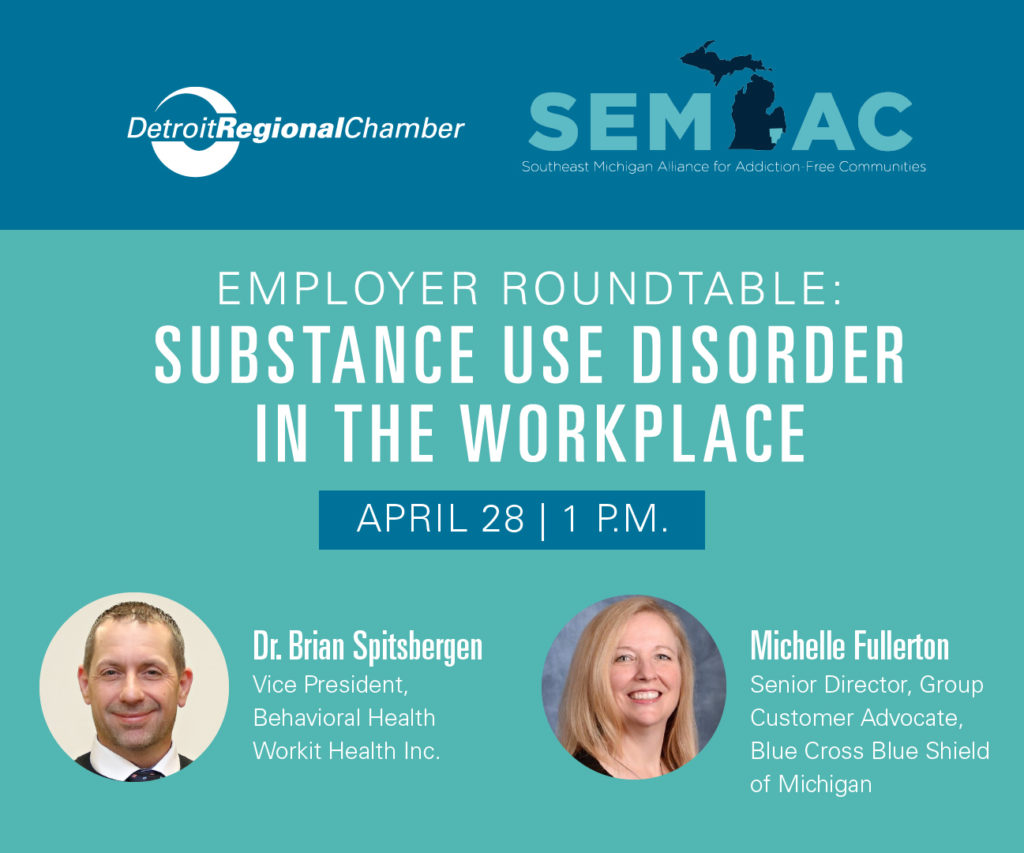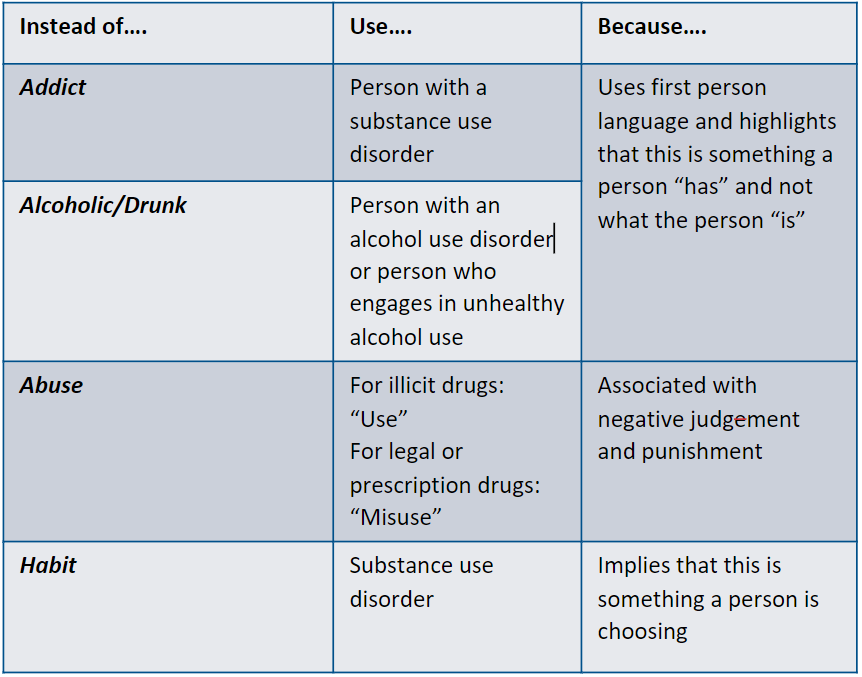
To cope with feelings of isolation, fear, and anxiety, many turn to substance usage outside of the workplace and risk the potential of developing unhealthy habits. However, the COVID-19 pandemic has now exacerbated the impact of substance use disorder in the workplace as well. Blue Cross Blue Shield of Michigan (BCBSM) has found a 34% increase in its members seeking mental health services and a 38% increase in members seeking substance use treatment between 2020 and 2021.
To expand on and provide solutions for this issue, the Detroit Regional Chamber hosted its Employer Roundtable: Substance Use Disorder in the Workplace event on April 28 in partnership with the Southeast Michigan Alliance for Addiction-Free Communities, Detroit Health Initiatives, and MPHI. There, regional health experts Michelle Fullerton, senior director and group customer advocate at BCBSM, and Dr. Brian Spitsbergen, vice president of behavioral health at Workit Health, shared employer strategies for addressing stigma, retaining talent, and supporting recovery.
Part 1: COVID-19 and Substance Use Disorders
Presented by Michelle Fullerton, senior director and group customer advocate, Blue Cross Blue Shield of Michigan
Key Takeaways
- Mental health and substance use conditions are increasing among all age groups.
- Nearly one in five Americans live with a mental illness.
- 75% of adults with substance use disorders are in the workforce.
- Stigma can lead to delays in treatment. It reduces the chances that a person with a behavioral health condition, such as substance use disorder, will receive care.
- Language matters. Changing how we talk about substance use and substance use disorders can help reduce stigma and lead to treatment.
- May is Mental Health Month. If your organization does not regularly share anti-stigma information about substance use disorders and behavioral health, now is a great time to start.
“The effects from the pandemic are real,” said Fullerton, “and they are anticipated for many years to come.”
Observations and Predictions from Blue Cross Blue Shield of Michigan
- Increased isolation due to more people being out of work or prolonged remote work.
- Increased alcohol use is evidenced by a 25.4% increase in alcohol sales in Wayne County.
- Delayed care or acknowledgment of substance use disorder due to isolation.
- A wave of treatment is predicted throughout 2022 due to delayed care.
Understanding and Addressing Stigma
Stigma involves negative attitudes or discrimination against someone based on a distinguishing characteristic such as a mental health condition or substance use disorder. Often, people do not seek care or treatment because of the stigma felt within themselves with thoughts like “I just need to snap out of it” or “I need to try harder.” This self-imposed stigma comes from how the public has historically viewed addiction as a matter of individual choice.
“It’s okay not to be okay,” said Fullerton, “It’s okay to feel stress, it’s okay to be burnt out, but it’s not okay to do nothing about it.”
Employers and HR leaders must understand the self-imposed and social stigma around mental health and substance use disorders, as the consequences of stigma can be severe and devastating. These consequences include reluctance to seek treatment, poor quality of life, fear, anger toward others, and increased feelings of shame and self-doubt.
“No group or individual is immune to substance use disorder. It’s not an inner-city, unemployed, low-income issue,” said Fullerton. “Honestly, data shows the prevalence of substance use disorder is actually among middle-aged women in suburbia.”
Acknowledging stigma and debunking myths can help an employee with a substance use disorder feel safe asking for help.
Employer Strategies
“We need to make sure people feel supported – that they can talk about it and go get treatment,” said Fullerton, challenging employers to normalize these crucial conversations in the workplace.
Anti-stigma messaging and information should be shared regularly across your organization if it does not already do so. May is a great time to start, as it’s Mental Health Awareness Month.
“We need to make sure people feel supported – that they can talk about it and go get treatment,” said Fullerton, challenging employers to normalize these crucial conversations in the workplace.
Words Matter

Part 2: Substance Use Disorder in Society
Presented by Dr. Brian Spitsbergen, vice president of behavioral health, Workit Health
Key Takeaways
- Addiction is a substance use disorder and primary health condition that can lead to a decline in other health conditions – mental, emotional, and physical.
- 20.8 million Americans have a substance use disorder.
- 70% of those with substance use disorders are employed, and 90% of those individuals will not find the help they need. This is an opportunity for employers.
- Substance use disorders have a significant impact in the workplace.
- Benefits of recovery solutions in the workplace include cost savings, lower turnover, reduced absenteeism, risk mitigation, and morale.
- Before having a crucial conversation with an employee with a substance use disorder, employers should prepare to achieve the best outcome.
Substance Use in the Workplace
“As a system, we have a long way to go,” said Spitsbergen, referencing stigma’s dangerous impact on preventing someone from seeking treatment.
- 23% of working adults report drinking before or during work or working under the influence of alcohol or other illicit drugs.
- 65% of on-the-job accidents are related to alcohol or other drug use.
- 29 workdays per year are missed by employees with an active pain medication disorder.
- $92 billion has been lost in profits due to the opioid crisis.
- There had been a 600% increase in opioid-related overdose deaths over 10 years.
- 21% of employees report being negatively affected by a co-worker’s drinking, including being put in danger, re-doing work, covering for a co-worker, and working harder and longer.
Signs of Substance Use Disorder Problems at Work
- Emotional change(s)/volatility
- Inability to adapt/problem solve
- Risky/inappropriate behavior
- Legal problems
- Health issues (lifestyle-related)
- Erratic behavior
- Defensive, argumentative
- Diminishing job results
- Poor performance
- Consistently late/no show
- Conflicts with co-workers/supervision
- Lack of awareness about inappropriate behavior
- Personal issues override work responsibilities
- Asks for wage increase/raise outside of the established system
- Seeks paycheck advance
Recovery Solutions Benefit Everyone
“Substance use disorder not only has an impact on dollars,” said Spitsbergen, “but also growth, morale, and having people get along.”
- Cost Savings: Every employee who recovers from a substance use disorder saves their company more than $3,200 in health care costs.
- Lower Turnover: Employees in recovery help employers avoid $1,626 in related turnover and replacement costs.
- Reduce Absenteeism: Employees in recovery miss five fewer workdays per year than employees with an active substance disorder.
- Mitigate Risk: Employees in recovery are far less likely to have workplace accidents or initiate a worker’s comp claim.
Strategies for Employers
Preparing for the conversation is crucial. Employers should first talk with HR and gather resources to share to achieve the best outcome for the employee suspected of dealing with a substance use disorder. Next, make an appointment with the employee and ensure they feel psychologically and physically safe. Finally, employers should approach the conversation with emotional intelligence and prepare for defense mechanisms.
“For most people, it is difficult to talk about,” said Spitsbergen, “It is absolutely normal human behavior to have built-in defense mechanisms. We need to know what people are willing to do to get help. There is a big difference between wanting treatment and what they are willing to do.”
Again, Words Matter
What NOT to say: “I think you might have a drinking problem,” or “You need to get it together.”
What TO say:
- “This may be a difficult conversation, but I want to share some observations.”
- “I have some concerns that I want to discuss with you.”
- “My goal today is to identify a plan of action to support you.”
Developing policy and conversation are not always enough. Employers need to create safe spaces where these crucial conversations are normalized so that employees can receive the care they need.
To learn more, view the full presentation on the Detroit Regional Chamber’s YouTube channel.